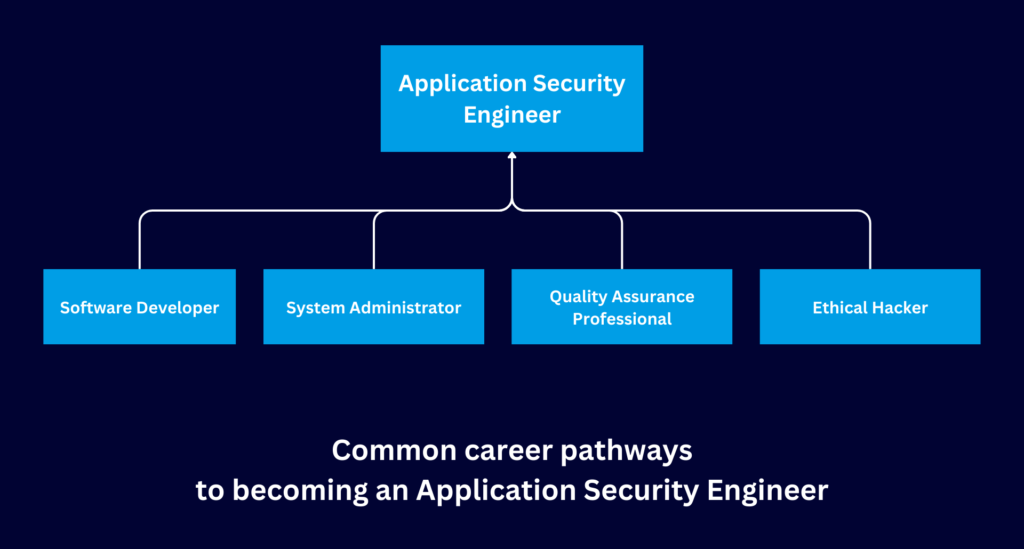
Application security is turning out to be a major concern. According to the Verizon 2024 Data Breach Investigations Report, data breaches involving vulnerability exploitation tripled from the previous year. This essentially means that attackers are increasingly targeting software vulnerabilities to carry out data breaches, highlighting the importance of adhering to secure coding practices and other measures to minimize the risk of these vulnerabilities.
That responsibility typically lies in the hands of Application Security Engineers, who make sure that weaknesses in not only applications, but also in operating systems and other types of software, are identified, mitigated, and prevented throughout the Software Development Lifecycle (SDLC).
If you’re a software developer, system administrator, or IT professional interested in cybersecurity, you may find this role to be both a rewarding and challenging career path.
In this article, we’ll cover what an Application Security Engineer does, the skills and qualifications required, and how to kickstart your journey toward this in-demand career.
What is an Application Security Engineer?
An Application Security Engineer focuses on safeguarding applications throughout their lifecycle, from design, through development, to deployment and beyond. Unlike other cybersecurity roles that deal with network or endpoint security, AppSec Engineers work directly within the Software Development Lifecycle (SDLC) to identify and fix vulnerabilities. They aim to “shift left” by integrating security into the development process rather than tacking it on as an afterthought.
If ever you choose to be an application security engineer, you would typically collaborate with software developers, DevSecOps teams, and system administrators to implement secure coding practices, conduct vulnerability assessments, and ensure that applications adhere to security standards such as the Open Worldwide Application Security Project (OWASP) guidelines.
Key roles and responsibilities – What does an Application Security Engineer do?
As an Application Security Engineer, your day-today responsibilities often involves a mix of technical analysis, collaboration, and proactive planning. Since application security engineers are charged with securing software throughout their SDLC, your core responsibilities can be grouped into three key phases:
- When architecting and designing the software
- During software development
- After deployment
1. When Architecting and Designing the Software
When application security is introduced at this stage, which is at the start of the SDLC, the goal is to bake security into the application’s foundation. As such, your key responsibilities usually include:
- Threat Modeling: Identifying potential attack vectors based on the planned architecture and application design.
- Defining Security Requirements: Collaborating with software architects, development teams, and other stakeholders to include security standards in the application’s requirements and ensuring compliance with frameworks like the OWASP Top 10 or National Institute of Standards and Technology or NIST standards.
- Application Architecture Review: Evaluating the software architecture to ensure it supports best practices such as secure data flow, secure authentication mechanisms, and proper access control.
- Security Tool Selection and Integration Planning: Choosing tools for static, dynamic, and interactive security testing (e.g., SAST and DAST) and planning their integration into the DevSecOps pipeline.
When you address security at the design stage, you help development teams “shift left,” minimizing vulnerabilities before coding begins.
2. During Software Development
In this phase, you’ll normally be doing hands-on collaboration with developers to implement and verify secure coding practices. Your responsibilities include:
- Secure Coding Guidance: Ensuring software developers adhere to best practices such as input validation, output encoding, and secure session management (e.g., avoiding SQL injection and cross-site scripting vulnerabilities).
- Code Reviews: Conducting manual and automated code reviews to identify and remediate vulnerabilities, particularly those highlighted in the OWASP Top 10.
- Automating Security Checks in CI/CD Pipelines: Integrating tools like static application security testing (SAST), dynamic application security testing (DAST), and dependency scanners into the development workflow to catch vulnerabilities early.
- Developer Training: Educating development teams on secure coding practices, Java, .NET, and Python best practices, and how to avoid common vulnerabilities.
This phase is critical for ensuring vulnerabilities are caught during development rather than after deployment.
3. Post-Deployment
Once the application is live, the focus shifts to monitoring, maintenance, and response. Your responsibilities at this stage include:
- Vulnerability Scanning: Regularly scanning the application for new vulnerabilities introduced by software updates, third-party libraries, or evolving threats.
- Penetration Testing: Simulating attacks to evaluate how the application holds up under real-world attack scenarios.
- Incident Response: Assisting operations teams in responding to breaches or exploit attempts.
- Patch Management: Coordinating with developers to remediate vulnerabilities identified in production and ensuring updates don’t compromise application performance or security.
- Continuous Improvement: Analyzing incidents and feedback to improve the security posture of future versions of the software.
How Much Does an Application Security Engineer Make?
Application Security Engineer salaries may vary depending on several factors, with location and experience level being two of the most significant determinants. Here are some rough estimates of the salary ranges you can find in different countries. For more accurate and up-to-date information, you can check salary research platforms, such as Glassdoor, PayScale, and Indeed.
| Location | Average (annual) salary range (USD) | ||
| Entry-level | Mid-level | Senior-level | |
| United States | $91,589 – $122,890 | $122,890 – $143,780 | $143,780 – $225,710 |
| Australia | $58,500 – $84,500 | $84,500 – $97,500 | $97,500 – $117,000 |
| United Kingdom | $51,250 – $85,000 | $85,000 – $106,250 | $106,250 – $125,000 |
| United Arab Emirates | $48,600 – $97,200 | $97,200 – $121,500 | $121,500 – $145,800 |
| South Africa | $9,720 – $22,032 | $22,032 – $32,400 | $32,400 – $44,064 |
| India | $6,000 – $12,000 | $12,000 – $18,000 | $18,000 – $24,000 |
How to Become an Application Security Engineer
If you’d like to pursue a career as an Application Security Engineer, here’s a step-by-step guide to help you break into the field.
Educational Foundation
Most Application Security Engineers have a bachelor’s degree in a relevant field, such as Computer Science, Cybersecurity, or Software Engineering. A strong academic background helps build foundational knowledge in:
- Programming languages like Java, Python, and .NET
- Computer networks and system administration
- Application and operating system architecture
- Concepts like data structures, algorithms, and object-oriented programming
- SDLC principles
- Foundational security principles
Certifications
Certifications are a great way to validate your expertise and stand out to potential employers. More importantly, in order to earn these certifications, you need to acquire knowledge and skills that are valuable to application security engineering. Here are some of the most relevant certifications for an Application Security Engineer:
- Certified Application Security Engineer (CASE) by EC-Council
- EC-Council Certified DevSecOps Engineer (ECDE)
- Web Application Hacking and Security (WAHS) by EC-Council
- GIAC Web Application Defender (GWEB)
- GIAC Web Application Penetration Tester (GWAPT)
- Certified Secure Software Lifecycle Professional (CSSLP) by ISC2
- Information Systems Security Architecture Professional (ISSAP) by ISC2
If you have zero background in cybersecurity, you can take these entry-level certifications first:
- Security+ by Comptia
- Google Cybersecurity Professional Certificate at Coursera
- Microsoft Cybersecurity Analyst Professional Certificate at Coursera
Relevant Skills
In addition to formal education and certifications, we recommend you master the following skills to boost your chances of succeeding as an Application Security Engineer:
- Vulnerability identification: Before you can defend or remediate software vulnerabilities, you often have to hunt and identify them first.
- Programming and Scripting: Expertise in languages like Java, .NET, and Python is essential, as they are commonly used in software development.
- Secure Coding Practices: Knowledge of frameworks and libraries that minimize vulnerabilities (e.g., input validation and secure session handling) is vital.
- Application Architecture and Threat Modeling: A solid understanding in the design of software systems can help you in identifying and addressing security flaws.
- Familiarity with Security Standards: Standards like OWASP Top 10, NIST, and ISO 27001 provide essential guidelines for application security.
- Tool Proficiency: Experience with tools for static analysis (SAST), dynamic analysis (DAST), and interactive application security testing (IAST) is key for this role.
Experience
Practical experience plays a critical role in breaking into this field, as an application security engineer is not an entry-level position. You can gain relevant experience in the following areas of expertise:

Software Development
Many AppSec Engineers start their careers as software developers. The firsthand experience you acquire in building, testing, and deploying software enables you to identify potential vulnerabiltiies in software as well as in the SDLC. Moreover, since you’d be familiar with development jargon, you’d be more capable in communicating with development teams should you be tasked to conduct code reviews or secure coding training.
System Administration
System administration experience helps you understand the underlying infrastructure where applications run, including servers, operating systems, and networks. As an Application Security Engineer, you’ll often work to ensure that applications are deployed securely and that the underlying infrastructure supports robust security standards. Additionally, your familiarity with patching vulnerabilities and maintaining system integrity gives you insight into mitigating risks at the system level.
Quality Assurance (QA) or Software Testing
As a QA professional, you develop an eye for spotting flaws in functionality, performance, and stability—skills that translate well to detecting security vulnerabilities. In addition, you’ll be exposed to testing methodologies and tools, such as automated testing frameworks, which can in turn help you understand SAST and DAST processes.
Bug bounty programs
Bug bounty programs are initiatives run by organizations to incentivize ethical hackers, security researchers, or developers in finding and reporting vulnerabilities or bugs in their (the organizations’) applications, software, or systems. Since you’ll be hunting for vulnerabilities, you’ll be honing a key skill needed in application security. You can participate in bug bounty programs through platforms like HackerOne, Bugcrowd, and YesWeHack.
Conclusion
As organizations increasingly prioritize building secure applications and securing existing applications, Application Security Engineers play a vital role in helping those organizations fulfill their security goals. If you have a passion for coding, cybersecurity, and application architecture, this career offers immense opportunities for growth. By combining education, certifications, and hands-on experience, you can carve out a successful path in this exciting field.
Whether you’re a software developer, system administrator, or aspiring IT professional, now is the perfect time to start your journey toward becoming an Application Security Engineer.